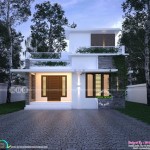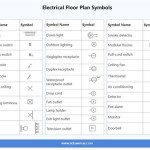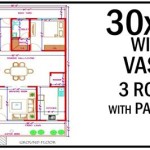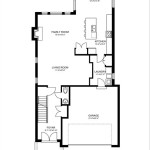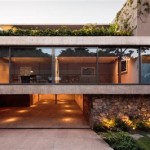Floor Plan 80 Sqm Bungalow House Design: Optimizing Space and Functionality
The 80 square meter bungalow represents a popular housing choice, particularly for small families, couples, or individuals seeking a manageable and cost-effective living space. Its compact size necessitates careful planning and efficient use of space. A well-designed floor plan is crucial to maximizing comfort, functionality, and aesthetics within these spatial constraints. This article explores key considerations and design approaches for creating an effective 80 sqm bungalow floor plan.
Understanding User Needs and Lifestyle
Before embarking on the design process, a thorough understanding of the intended occupants’ needs and lifestyle is paramount. This involves considering factors such as family size, work habits, hobbies, and any special requirements like accessibility for elderly or disabled individuals. This detailed assessment will inform decisions regarding the number of bedrooms, bathroom layout, kitchen configuration, and the allocation of space for living and dining areas.
For instance, a young couple might prioritize a larger open-plan living area for entertaining, while a family with children may need more dedicated bedroom space and a separate play area. Similarly, individuals who work from home will require a dedicated office space or a study nook. The design should also take into account the occupants’ aesthetic preferences and desired ambiance, whether it's a modern minimalist style or a more traditional and cozy setting.
Furthermore, future needs should be considered. Will the family size likely increase? Is aging in place a priority? Anticipating these future requirements can prevent costly renovations down the line and ensure the bungalow remains suitable for the long term. This might involve incorporating features like wider doorways, grab bars in bathrooms, or a flexible layout that can be easily adapted to accommodate changing needs.
Maximizing Space Efficiency
In an 80 sqm bungalow, every square meter counts. Employing space-saving strategies becomes essential. One common approach is to embrace open-plan living, combining the living room, dining area, and kitchen into a single, flowing space. This creates a sense of spaciousness and allows natural light to permeate the entire area. However, careful zoning is still necessary within the open plan to define distinct activity areas and maintain a sense of order.
Built-in storage solutions are another effective way to maximize space. This can include wall-to-wall cabinets, under-stair storage, and integrated shelving units. By utilizing vertical space and minimizing clutter, the overall feeling of spaciousness can be significantly enhanced. Multifunctional furniture, such as sofa beds, foldable tables, and storage ottomans, can also play a crucial role in optimizing space utilization.
The layout of hallways and corridors should also be carefully considered. Long, narrow hallways can be inefficient and consume valuable living space. Where possible, hallways should be minimized or eliminated altogether, with rooms directly accessible from the main living area. Alternatively, hallways can be widened and incorporated into the living space, serving as gallery walls or areas for display cabinets.
Another strategy is to utilize outdoor spaces effectively. A well-designed patio or deck can extend the living area outdoors, providing additional space for relaxation and entertaining. This is particularly beneficial in climates with mild weather. Large windows and sliding doors can blur the boundaries between indoor and outdoor spaces, further enhancing the sense of openness and connection to nature.
Key Functional Areas and Layout Considerations
The following section discusses key functional areas within the 80 sqm bungalow and provides guidance on their layout and design.
Bedrooms
The number of bedrooms will depend on the occupants’ needs and preferences. A typical 80 sqm bungalow might accommodate two or three bedrooms. The master bedroom should ideally be positioned to maximize privacy and natural light. Consider incorporating an ensuite bathroom and walk-in closet for added convenience. Secondary bedrooms can be smaller but should still provide adequate space for a bed, wardrobe, and study desk.
Bedroom layout should prioritize functionality and comfort. Arrange furniture to maximize circulation space and avoid overcrowding. Built-in wardrobes can help to minimize clutter and maximize storage space. Consider the placement of windows and doors to ensure adequate ventilation and natural light. Soundproofing materials can be used to minimize noise transmission between bedrooms and other areas of the house.
Bathrooms
The layout of bathrooms should prioritize functionality and hygiene. A well-designed bathroom should include a toilet, sink, and shower or bathtub. Space-saving fixtures, such as wall-mounted toilets and corner sinks, can be used to maximize space in smaller bathrooms. Separate the shower or bathtub area with a glass screen or curtain to prevent water from splashing onto the floor. Proper ventilation is essential to prevent mold and mildew growth.
The number of bathrooms will depend on the size of the household and the budget. A single bathroom may be sufficient for a small family, while larger families may require two bathrooms. Consider adding a powder room near the entrance for guests. Pay attention to accessibility requirements, especially if elderly or disabled individuals are living in the house. This might involve incorporating grab bars, a walk-in shower, and a raised toilet seat.
Kitchen and Dining Area
The kitchen is the heart of the home and should be designed for functionality and efficiency. The layout should facilitate easy workflow and minimize unnecessary steps. A typical kitchen layout includes a work triangle connecting the sink, refrigerator, and stovetop. Consider incorporating ample counter space for food preparation. Built-in cabinets and drawers can provide storage for cookware, utensils, and groceries. Good lighting is essential for safety and efficiency.
The dining area should be located adjacent to the kitchen for easy serving and cleanup. A small dining table and chairs may be sufficient for a small family, while a larger table may be needed for entertaining guests. Consider incorporating a breakfast bar or island counter for informal dining. Natural light can create a pleasant ambiance in the dining area. Ensure adequate space for circulation around the table and chairs.
Living Area
The living area is the central gathering space for the household. It should be designed for comfort and relaxation. The layout should facilitate conversation and movement. Arrange furniture to create a focal point, such as a fireplace or television. Consider incorporating ample seating for family and guests. Natural light and ventilation are essential for creating a pleasant atmosphere. Choose comfortable and durable materials for flooring, walls, and furniture. The living area should be easily accessible from other areas of the house.
Consider integrating the living area with outdoor spaces through large windows or sliding doors. This can create a sense of openness and connection to nature. A well-designed patio or deck can extend the living area outdoors, providing additional space for relaxation and entertaining. Consider the placement of electrical outlets and lighting fixtures to accommodate various activities, such as reading, watching television, or playing games.

80 Sq M Modern Bungalow House Design With Roof Deck Engineering Discoveries

80 Sq M Modern Bungalow House Design With Roof Deck Engineering Discoveries

80sqm 3 Bedroom House Plans With Photos Plandeluxe

80 Sqm Floor Plan Google Search

Pin By Robson GonÇalves Da Silva On Nova Habitar Bungalow Style House Plans Simple Design

House Plans Choose Your By Floor Plan Djs Architecture

80 Sqm Bungalow House Design Konsepto Designs

Two Bedroom Small House Design Phd 2024035 Pinoy Designs

80 Sqm Bungalow House Design Konsepto Designs

Small House Design Idea 8x10 Meters 80sqm With Three Bedrooms


